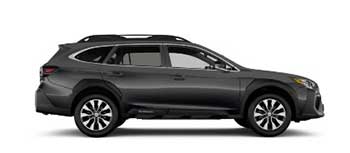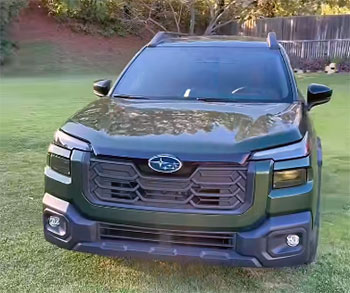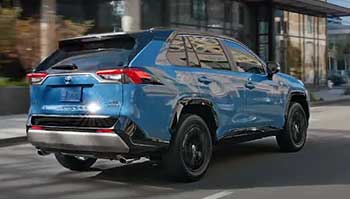As a car enthusiast who’s spent countless hours behind the wheel, I’m thrilled to share my insights on two of the most popular SUVs on the market: the Subaru Outback and the Toyota RAV4.
My goal is to help you navigate their key features, weigh their strengths and weaknesses, and decide which one suits your lifestyle.
Whether you’re an adventure seeker or a daily commuter, this article will break down performance, reliability, and value to guide your choice.
Comparison Table
| Feature | Subaru Outback (2025) | Toyota RAV4 (2025) |
|---|---|---|
| Starting MSRP | $30,315 | $30,245 |
| Engine Options | 2.5L 4-cylinder (182 hp), 2.4L turbo (260 hp) | 2.5L 4-cylinder (203 hp), Hybrid (219 hp) |
| Drivetrain | Standard AWD | FWD standard, AWD optional |
| Fuel Economy (City/Hwy) | 26/32 MPG (base), 22/29 MPG (turbo) | 27/35 MPG (gas), 41/38 MPG (hybrid) |
| Cargo Space (Max) | 75.6 cu. ft. | 69.8 cu. ft. |
| Towing Capacity | Up to 3,500 lbs | Up to 1,500 lbs (gas), 1,750 lbs (hybrid) |
| Ground Clearance | 8.7 in. (base), 9.5 in. (Wilderness) | 8.4 in. (gas), 8.1 in. (hybrid) |
| Infotainment | 7-in. or 11.6-in. touchscreen | 8-in. or 10.5-in. touchscreen |
| Safety Rating | IIHS Top Safety Pick+ (11 years running) | IIHS Top Safety Pick, NHTSA 5-star |
| Reliability (J.D. Power) | 80/100 (Average) | 80/100 (Average) |
My Experience With Subaru Outback

I’ve had the pleasure of driving a 2023 Subaru Outback Wilderness for a weekend trip through the Smoky Mountains, and it left a lasting impression.
The Outback feels like a trusty companion, blending the ruggedness of an SUV with the smooth ride of a station wagon.
Its standard Symmetrical All-Wheel Drive gripped winding, rain-slicked roads with ease, and the 9.5 inches of ground clearance let me tackle a muddy trail without hesitation. The turbocharged 2.4-liter engine delivered a punchy 260 horsepower, making passing on steep inclines effortless.
Inside, the cabin felt spacious, with 75.6 cubic feet of cargo space swallowing camping gear for four without a Tetris-like packing session. The 11.6-inch vertical touchscreen was intuitive, though I found wired Apple CarPlay a tad clunky compared to wireless options.
The EyeSight safety suite, with adaptive cruise control and lane-keeping assist, kept me confident on long stretches of highway. However, the base engine’s 182 horsepower felt underpowered on previous test drives, and fuel economy (22 MPG combined on the turbo) wasn’t stellar. Still, the Outback’s off-road prowess and roomy interior make it a standout for adventure lovers like me.
Read more: My Thoughts on Honda Odyssey Vs. Subaru Ascent
Pros Of Subaru Outback
- Standard All-Wheel Drive: Every Outback comes with Symmetrical AWD, offering superior traction on snow, mud, or gravel without extra cost.
- Impressive Towing Capacity: With up to 3,500 pounds of towing, it hauls trailers or small boats, outpacing most compact SUVs.
- Spacious Cargo Area: 75.6 cubic feet of max cargo space fits bulky gear, perfect for camping or moving days.
- Off-Road Capability: The Wilderness trim’s 9.5-inch ground clearance and X-MODE tackle rough terrain with confidence.
- Top Safety Ratings: An IIHS Top Safety Pick+ for over a decade, with standard EyeSight features like pre-collision braking.
- Versatile Engine Options: Choose between a fuel-efficient 2.5-liter or a powerful 2.4-liter turbo for tailored performance.
- Comfortable Ride: Its longer wheelbase ensures a smoother ride on highways compared to shorter SUVs.
The Outback’s AWD system is a game-changer for those in harsh climates or seeking off-road adventures. Its towing capacity and cargo space make it a practical choice for families or outdoor enthusiasts. The safety suite and ride comfort add to its appeal, though the turbo engine’s thirst for fuel is worth noting.
Cons Of Subaru Outback

- Mediocre Fuel Economy: The base engine gets 26/32 MPG, but the turbo drops to 22/29, lagging behind hybrid competitors.
- Base Engine Lacks Power: The 182-horsepower 2.5-liter feels sluggish, especially when fully loaded or climbing hills.
- Higher Repair Costs: Average annual repair costs around $607, higher than some rivals due to AWD complexity.
- Wired Connectivity: Base models lack wireless Apple CarPlay, which feels dated in 2025.
- Price Creep: Starting at $30,315, it’s slightly pricier than competitors with similar features.
- Infotainment Learning Curve: The 11.6-inch touchscreen can overwhelm with menus, requiring adjustment.
- Average Reliability: J.D. Power scores it 80/100, solid but not class-leading.
While the Outback shines off-road, its fuel economy and base engine performance disappoint. Repair costs and wired connectivity are minor gripes, but they add up for budget-conscious buyers. The infotainment system, while feature-rich, isn’t as user-friendly as some rivals.
Maintenance Tips For Subaru Outback
- Regular Oil Changes: Use synthetic 0W-20 oil every 6,000 miles to keep the BOXER engine running smoothly.
- Tire Rotations: Rotate tires every 6,000 miles to ensure even wear, especially with AWD stress.
- Brake Inspections: Check brakes annually, as AWD systems can accelerate pad wear on rough terrain.
- CVT Fluid Replacement: Replace CVT fluid every 60,000 miles to maintain smooth shifting.
- Air Filter Checks: Inspect cabin and engine air filters every 15,000 miles for optimal performance.
- Battery Maintenance: Test the battery yearly, as cold climates can strain it in AWD vehicles.
- Alignment Checks: Schedule alignments annually to prevent uneven tire wear from off-road driving.
Maintaining an Outback isn’t overly complex, but its AWD system demands attention. Regular oil changes and tire rotations keep it reliable, while CVT fluid and brake checks prevent costly repairs. These steps ensure your Outback stays adventure-ready for years.
My Experience With Toyota Rav4

I borrowed a 2024 Toyota RAV4 Hybrid XLE for a week of city commuting and a short road trip to the coast, and it won me over with its efficiency and polish. The hybrid’s 219 horsepower felt peppy in traffic, and I averaged an impressive 39 MPG combined, saving a noticeable chunk at the pump.
The 8-inch touchscreen was responsive, with wireless Apple CarPlay making navigation a breeze. The RAV4’s compact size made parking in tight urban spots stress-free, and its 37.6 cubic feet of cargo behind the rear seats handled groceries and beach gear easily.
However, the RAV4’s 8.1-inch ground clearance limited its off-road potential, and the optional AWD felt less robust than the Outback’s on gravel roads. The cabin, while functional, used hard plastics that felt less premium than rivals.
Towing is capped at 1,750 pounds for the hybrid, which pales next to the Outback. Still, the RAV4’s reliability and fuel economy make it a smart pick for urban dwellers or efficiency-focused drivers.
Pros Of Toyota Rav4
- Excellent Fuel Economy: Gas models hit 27/35 MPG, while hybrids reach 41/38, ideal for long commutes.
- Hybrid Powertrain Option: The 219-horsepower hybrid balances power and efficiency, unavailable in the Outback.
- Lower Repair Costs: Average annual repair cost of $429, among the lowest in its class.
- Compact Size: Easier to park and maneuver in cities than the longer Outback.
- Modern Infotainment: Standard 8-inch touchscreen with wireless Apple CarPlay feels seamless.
- Strong Reliability: J.D. Power scores 80/100, with a reputation for long-term durability.
- Variety Of Trims: Gas, hybrid, and plug-in hybrid options cater to diverse needs.
The RAV4’s fuel efficiency and hybrid option shine for cost-conscious buyers. Its compact design and low maintenance costs make it a practical urban SUV, while the infotainment system feels cutting-edge. Reliability is a major draw for long-term ownership.
Cons Of Toyota Rav4
- Limited Towing Capacity: Maxes out at 1,500 pounds (gas) or 1,750 pounds (hybrid), weak for towing needs.
- Optional AWD: Standard FWD with AWD costing extra, unlike the Outback’s standard AWD.
- Less Cargo Space: 69.8 cubic feet max, smaller than the Outback’s 75.6 cubic feet.
- Basic Interior Materials: Hard plastics in the cabin feel cheap compared to premium rivals.
- Lower Ground Clearance: 8.4 inches (gas) or 8.1 inches (hybrid) limits off-road capability.
- Noisy Engine: The 2.5-liter gas engine gets loud under hard acceleration.
- Fewer Engine Options: Lacks a high-performance engine like the Outback’s turbo.
The RAV4’s towing and cargo limitations hinder its versatility. Optional AWD and lower ground clearance make it less adventure-ready, while the interior and engine noise detract from comfort. It’s a solid choice, but not without trade-offs.
Maintenance Tips For Toyota Rav4
- Oil Changes: Use 0W-16 synthetic oil every 10,000 miles for gas or hybrid engines.
- Tire Maintenance: Rotate tires every 5,000 miles to extend tread life, especially with AWD.
- Brake Fluid Flush: Replace brake fluid every 30,000 miles to maintain stopping power.
- Hybrid Battery Checks: Inspect hybrid battery cooling system annually for efficiency.
- Cabin Filter Replacement: Swap cabin air filter every 15,000 miles for clean air.
- Coolant Checks: Inspect engine coolant every 30,000 miles to prevent overheating.
- Wheel Alignment: Check alignment every 12,000 miles to avoid uneven tire wear.
The RAV4’s maintenance is straightforward, with longer oil change intervals for hybrids. Tire rotations and hybrid battery checks keep costs low, while coolant and brake fluid maintenance ensure reliability. These steps maximize the RAV4’s legendary durability.
Read more: My Thoughts on Acura Integra Vs. Honda Accord
Frequently Asked Questions (Faq)
It depends on your needs. The Outback excels for off-road adventures and towing, while the RAV4 is better for fuel efficiency and urban driving.
The RAV4 edges out slightly with lower repair costs ($429 vs. $607 annually), but both score 80/100 in J.D. Power reliability.
Yes, Subarus average $607 in annual repair costs compared to $429 for Toyotas, partly due to AWD complexity.
The Toyota RAV4 is the closest match, though the Highlander offers similar size and towing for larger families.
Conclusion: For Subaru Outback
You’re looking for a versatile SUV, and the Outback delivers with standard AWD, robust towing, and a cavernous cargo hold. It’s your go-to if trails and towing are your jam, but fuel economy and base engine power might leave you wanting. I found its off-road grit unmatched, making it ideal for adventurers.
Conclusion: For Toyota Rav4
The RAV4 is your pick if you value efficiency and urban agility. Its hybrid option and low maintenance costs are hard to beat, though limited towing and cargo space are drawbacks. My time with it proved it’s a reliable, fuel-sipping champ for city life.

